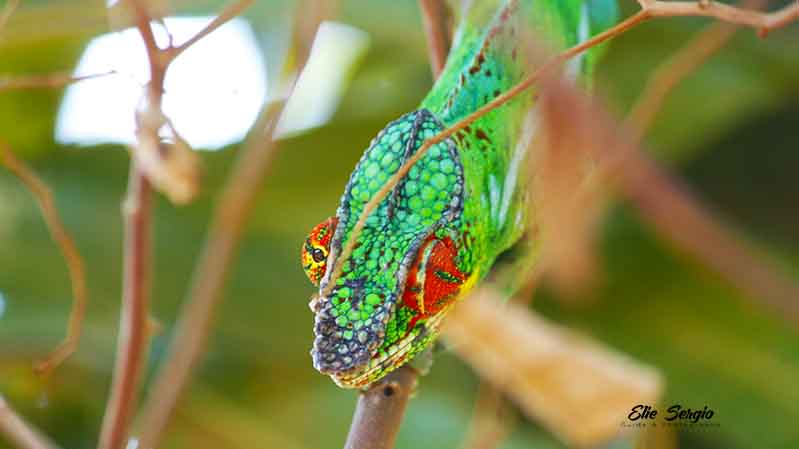Chameleon color change.
Chameleons are more than just lizards.
Chameleon color change, imagine standing in a lush, green forest, the air still and silent, when suddenly, a branch moves ever so slightly. You squint, only to realize that what you thought was part of the tree is actually a chameleon. And then, as if it’s part of nature’s grand performance, its skin begins to shift. Deep green fades into shades of yellow, then orange. It’s breathtaking, almost emotional—like watching an artist paint the air with life. But this isn’t just beauty for beauty’s sake. Every shift in color tells a story.
Let’s explore what makes these little creatures the most mesmerizing performers in the natural world.


Understanding the Chameleon
Chameleons are more than just lizards that change color—they are the very symbol of adaptation and survival. Found primarily in Madagascar, Africa, and parts of Asia, these reptiles have evolved in ways that make them stand out as one of nature’s most extraordinary creatures.
The Amazing World of Chameleons
With over 200 species, chameleons differ vastly in size, shape, and ability. Some are tiny enough to fit on the tip of your finger, while others, like the majestic Parson’s chameleon, are over a foot long. Despite their differences, they all share certain traits that make them uniquely chameleon—like their turreted eyes, which can move independently, and their prehensile tails, which allow them to grasp branches as if they were another limb.



Chameleon Species and their differences.
While all chameleons have the ability to change color, not all species do it in the same way. Some shift only from light to dark shades, while others, like the Panther Chameleon, can produce a dazzling array of colors. Each species has developed its own relationship with color based on its environment, habits, and needs.


The Magic Behind Chameleon Color Change.
It’s easy to think of a chameleon’s color change as purely cosmetic, but there’s real magic at work beneath their skin—science magic! At the heart of this ability are specialized skin cells known as chromatophores, which house different pigments.

Chromatophores – The Skin’s Color Palette.
Chromatophores are the primary tools in the chameleon’s color-shifting arsenal. These cells are arranged in layers under the skin, each containing different pigments. When the chameleon needs to shift shades, the cells expand or contract to control the intensity and visibility of certain colors.

How They Control Color Changes.
Think of chromatophores like tiny paintbrushes inside a chameleon’s skin. They can ‘paint’ the chameleon based on its surroundings, its mood, or its need to communicate. The combination of pigment and light reflection creates the kaleidoscope of colors we see on a chameleon’s body.

Why Do Chameleons Change Color?
Many people assume that chameleons change color solely for camouflage, but that’s just one of the many reasons. Their color change is a reflection of their mood, temperature, communication, and survival strategy.
Emotions in Color
Chameleons wear their emotions on their skin—literally. A stressed or frightened chameleon might turn dark or even black. In contrast, a relaxed or content one might adopt lighter, more peaceful tones.
Communicating Through Color.
One of the most touching aspects of a chameleon’s color change is its role in communication. A male chameleon showing off bright, vivid colors might be displaying dominance or attempting to attract a mate. It’s their way of speaking to the world without uttering a single sound.
Camouflage and Survival
Of course, chameleons are the masters of blending in. In the wild, being able to hide in plain sight can mean the difference between life and death. When a predator looms nearby, a quick color change can render them nearly invisible among leaves and branches.

The Science of Color Change.
Color change in chameleons isn’t just about pigment—there’s a fascinating structure at play that enhances this effect.
The Layers of the Skin.
Beneath the outermost layer of skin lies a complex structure of chromatophores and iridophores. Iridophores are special cells that reflect light using nanocrystals, and it’s the manipulation of these cells that allows chameleons to shift between vibrant and muted colors.
The Role of Iridophores and Nanocrystals.
Iridophores contain microscopic crystals that reflect light differently depending on how they’re spaced. When the spacing between these nanocrystals changes, the color reflected shifts dramatically—creating those stunning blues, greens, and reds we often associate with chameleons.


The Many Faces of Chameleons
Chameleons aren’t all the same, and neither is their ability to change color. While some species are renowned for their bright displays, others rely more on subtle shifts.
Not All Chameleons Change Color Equally
While a Panther Chameleon can flash brilliant reds, yellows, and blues, other species like the Jackson’s chameleon may stick to darker tones like browns and greens. The extent of color change varies, and it’s largely dependent on their environment and evolutionary needs.
Myths vs. Reality
One of the most common misconceptions is that chameleons always match their surroundings perfectly. In reality, they use color change more for communication and temperature regulation than for blending in with the scenery.


Chameleons in the Wild and in Captivity
The wild offers chameleons a rich tapestry of stimuli that influence their color changes. In captivity, however, their environment is controlled, and this can sometimes limit their color range.
Environment’s Role in Color Change
Sunlight, humidity, and temperature all affect a chameleon’s color. In the wild, these factors are ever-changing, but in captivity, artificial lighting and regulated temperatures can lead to duller, less frequent color changes.
Comparing Wild and Captive Chameleons
Chameleons in captivity may show signs of stress more easily, which can result in darker, less vibrant colors. In the wild, with fewer constraints, chameleons are more likely to display their full range of hues.
